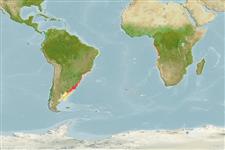Environment: milieu / climate zone / depth range / distribution range
Ökologie
seewasser demersal; tiefenbereich 10 - ? m (Ref. 27363). Subtropical; 1°S - 46°S, 68°W - 14°E
Eastern Atlantic: known only from larvae collected in the southern Gulf of Guinea from Annobon, Equatorial Guinea to Mossamedes (Moçâmedes), Angola. Western Atlantic: Rio de Janeiro, Brazil to San Jorge Gulf, Argentina (Ref. 86990).
Size / Gewicht / Alter
Maturity: Lm ? range ? - ? cm
Max length : 112 cm TL Männchen/unbestimmt; (Ref. 57911)
Kurzbeschreibung
Morphologie | Morphometrie
Pectorals small and fan-shaped (Ref. 27363).
Found in shallow waters of the continental shelf (Ref. 27363). Feeds on fishes, shrimps, crabs and mollusks.
Life cycle and mating behavior
Geschlechtsreife | Fortpflanzung | Ablaichen | Eier | Fecundity | Larven
Specimens captured in deep waters of Brazil had ovaries occupying the whole abdominal cavity with scarce adipose tissue and degraded body indicative of semelparity (Ref. 92882).
Smith, D.G., 1990. Congridae. p. 156-167. In J.C. Quero, J.C. Hureau, C. Karrer, A. Post and L. Saldanha (eds.) Check-list of the fishes of the eastern tropical Atlantic (CLOFETA). JNICT, Lisbon; SEI, Paris; and UNESCO, Paris. Vol. 1. (Ref. 4453)
IUCN Rote Liste Status (Ref. 130435)
Bedrohung für Menschen
Harmless
Nutzung durch Menschen
Fischereien: weniger kommerziell
Mehr Information
ReferenzenAquakulturAquakultur ProfilZuchtlinienGenetikElectrophoresesVererbbarkeitKrankheitenVerarbeitungNutrientsMass conversion
PartnerBilderStamps, Coins Misc.LauteCiguateraGeschwindigkeitSchwimmstilKiemenoberflächeOtolithsGehirngrößeSehfähigkeit
Tools
Zusatzinformationen
Download XML
Internet Quellen
Estimates based on models
Preferred temperature (Ref.
123201): 11.8 - 24.9, mean 15.8 °C (based on 168 cells).
Phylogenetic diversity index (Ref.
82804): PD
50 = 0.5000 [Uniqueness, from 0.5 = low to 2.0 = high].
Bayesian length-weight: a=0.00043 (0.00024 - 0.00076), b=3.23 (3.08 - 3.38), in cm total length, based on LWR estimates for this species & Genus-body shape (Ref.
93245).
Trophic level (Ref.
69278): 3.7 ±0.59 se; based on food items.
Generation time: 7.3 ( na - na) years. Estimated as median ln(3)/K based on 1
growth studies.
Widerstandsfähigkeit (Ref.
120179): mittel, Verdopplung der Population dauert 1,4 - 4,4 Jahre. (Assuming tm<5).
Fishing Vulnerability (Ref.
59153): High vulnerability (61 of 100).
Climate Vulnerability (Ref.
125649): Moderate vulnerability (38 of 100).
Nutrients (Ref.
124155): Calcium = 44.1 [26.7, 86.9] mg/100g; Iron = 0.851 [0.485, 1.384] mg/100g; Protein = 18.6 [15.8, 21.4] %; Omega3 = 0.3 [0.1, 0.8] g/100g; Selenium = 52.3 [28.1, 102.7] μg/100g; VitaminA = 7.4 [2.2, 24.5] μg/100g; Zinc = 0.556 [0.410, 0.786] mg/100g (wet weight);
